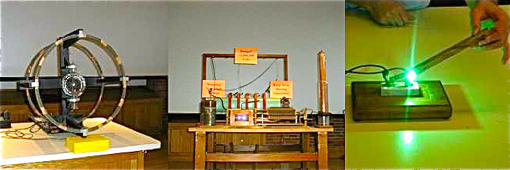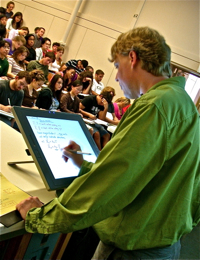Physics 2208: Fundamentals of Physics II

Physics 2208 lecture demonstrations.
Physics 2207 and 2208 is a two-semester introduction to physics with emphasis on tools generally applicable in sciences, intended for students majoring in physical science, mathematics, or analytically oriented biological science. Physics 2208 covers electricity and magnetism, topics from geometrical and physical optics, and quantum and nuclear physics.
Syllabus
- Electric charge, field,forces, and potential
- Electric currents and circuits
- Forces, Friction
- Magnetic fields and forces
- Sources of magnetic fields
- Electromagnetic waves
- Geometrical optics
- Interference and diffraction
- Elasticity
- Quantum mechanics
- Nuclear and particle physics
Suggested Literature
- Fundamental of Physics, 9th ed., Volume 2, by Halliday, Resnick, and Walker
- University Physics for the Physical and Life Sciences, Volume 2, by Kesten and Tauck
Lecture Notes
I do allow my lectures notes, syllabi, and other course materials to be freely shared and distributed under a Creative Commons Attribution-NonCommercial-ShareAlike license; please see below for details.
- Lecture 1: Introduction, electric charge and forces
- Lecture 2: Insulators and conductors; polarization
- Lecture 3: Electric fields
- Lecture 4: Field lines, electric dipole
- Lecture 5: Gauss' law
- Lecture 6: Electric potential energy and electric potential
- Lecture 7: More on the electric potential
- Lecture 8: Capacitors
- Lecture 9: Electric field energy, capacitors, dielectrics, current
- Lecture 10: Current density; current in metals
- Lecture 11: Electrical resistance, power
- Lecture 12: Resistors, emf, electric power
- Lecture 13: RC circuit, magnetic fields, magnetic force
- Lecture 14: Magnetic fields; motion in uniform field
- Lecture 15: Mass spectrometer, Hall effect, force on wire
- Lecture 16: Torque on current loop; magnetic field by a moving charge
- Lecture 17: Magnetic fields by a current; forces on parallel currents
- Lecture 18: Ampere's law, straight wire, solenoid
- Lecture 19: Magnetic induction; Faraday's law
- Lecture 20: Induced emf; Lenz's law
- Lecture 21: Inductance, RL-circuits
- Lecture 22: Magnetic field energy; ac currents and average power
- Lecture 23: Transformer, LC circuit and oscillations
- Lecture 24: RLC-circuits; Faraday's law; Ampere-Maxwell law
- Lecture 25: Maxwell's equation; electromagnetic waves
- Lecture 26: Intensity and polarization of EM waves; polarizing filters
- Lecture 27: Reflection and refraction
- Lecture 28: Brewster angle; dispersion; images; flat mirror
- Lecture 29: Spherical mirrors; thin lenses
- Lecture 30: Lenses, interference of waves
- Lecture 31: Interference
- Lecture 32: Thin film interference
- Lecture 33: Diffraction (single slit; circular aperture)
- Lecture 34: N-slit interference; Bragg's law
- Lecture 35: Photons
- Lecture 36: Photoelectric effect; Compton effect
- Lecture 37: Compton effect; X-rays; spectra and the quantized atom
- Lecture 38: Lasers; particle waves
- Lecture 39: Wave function; Schroedinger's equation; free particle
- Lecture 40: Heisenberg's uncertainty principle; 1-D infinite square well
- Lecture 41: Nuclear physics; particle physics
Creative Commons License
Attribution-NonCommercial-ShareAlike 3.0 United States
You are free:
- to Share: to copy, distribute, display my lecture notes and course materials
- to Remix: to make derivative works
Under the following conditions:
- Attribution: You must attribute the work in the manner specified by the author or licensor (but not in any way that suggests that they endorse you or your use of the work).
- Noncommercial: You may not use this work for commercial purposes Share Alike. If you alter, transform, or build upon this work, you may distribute the resulting work only under the same or similar license to this one.
For any reuse or distribution, you must make clear to others the license terms of this work. The best way to do this is with a link to this web page. Any of the above conditions can be waived if you get permission from the copyright holder. Apart from the remix rights granted under this license, nothing in this license impairs or restricts the author's moral rights.
Your fair use and other rights are in no way affected by the above. This is a human-readable summary of the Legal Code (the full license ).

Using an electronic ink/ interactive pen display in lecture.
